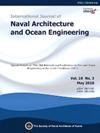An advanced technique to adjust hull girder load: Part 1 = generalisation
IF 3.9
3区 工程技术
Q2 ENGINEERING, MARINE
International Journal of Naval Architecture and Ocean Engineering
Pub Date : 2025-01-01
DOI:10.1016/j.ijnaoe.2025.100645
引用次数: 0
Abstract
In this study (Part 1), a method is proposed to adjust the loads to achieve the target hull girder load with or without local loads on ships and ship-like structures. Each force or pressure load is referred to as a local load and the sum of forces and moments integrated with respect to the station is referred to as the hull girder load or global load. The hull girder load is composed of axial force (AF), vertical shear force (VSF), horizontal shear force (HSF), torsional moment (TM), vertical bending moment (VBM) and horizontal bending moment (HBM), each of which is related to each other by forces in the x, y and z directions. The adjustment of hull girder loads is required in hull structural analyses with various model extents and boundary conditions. In the whole ship model, it is necessary to implement more accurate hull girder loads and in the cargo hold, fore and aft body model, it is necessary to adjust the hull girder loads calculated from local loads to the target value. In the adjustment of the hull girder load, it is not only important to adjust it more accurately to the target value, but also the distribution of the added load is very important. In general, the hull girder load is adjusted to the target value by adding forces in the x, y and z directions to nodes in the cross section of the hull. If the forces are placed by considering only the position of the nodes, the loads may be concentrated or applied in a different direction from the placement of the elements, resulting in unexpected stresses or deformations in the structural analysis. It is necessary to consider not only the node position but also the size and orientation of the element for force distribution. In this paper, the load distribution at each node is obtained from the product of the directional effective area of the element and the stress field of the beam. The proposed method is validated by adjusting the hull girder loads to the target value for a beam structure with idealised hull. The method proposed in this study will be applied to actual ships in Part 2 (Jang and Kim, 2025a), and its applicability and extendibility are to be verified. This is considered to be beneficial for ship and offshore structural designers including oil/gas and ocean mobilities.

一种调整船体梁载的先进技术:第1部分:概述
在本研究(第1部分)中,提出了一种船舶及类船结构在有无局部荷载的情况下,通过调整荷载达到船体梁目标荷载的方法。每个力或压力荷载被称为局部荷载,力和力矩的总和被称为船体梁荷载或整体荷载。船体梁荷载由轴向力(AF)、垂直剪力(VSF)、水平剪力(HSF)、扭转力矩(TM)、垂直弯矩(VBM)和水平弯矩(HBM)组成,各弯矩之间通过x、y、z方向的力相互关联。在不同模型范围和边界条件下的船体结构分析中,需要对船体梁荷载进行调整。在全船模型中,需要实现更精确的船体梁载荷,在货舱、前后船体模型中,需要将计算的船体梁载荷从局部载荷调整到目标值。在船体梁荷载的调整中,不仅要将其更准确地调整到目标值,而且附加荷载的分布也很重要。一般情况下,通过在船体横截面节点上增加x、y、z方向的力,将船体梁荷载调整到目标值。如果只考虑节点的位置来施加力,则载荷可能会集中或施加在与单元位置不同的方向上,从而导致结构分析中出现意想不到的应力或变形。力的分布不仅要考虑节点的位置,还要考虑单元的大小和方向。本文通过单元的定向有效面积与梁的应力场的乘积得到各节点处的荷载分布。通过将理想船体梁结构的船体梁荷载调整到目标值,验证了该方法的有效性。本研究提出的方法将在第2部分(Jang and Kim, 2025a)中应用于实际船舶,并验证其适用性和可扩展性。这被认为是有利于船舶和海上结构设计师,包括石油/天然气和海洋移动。
本文章由计算机程序翻译,如有差异,请以英文原文为准。
求助全文
约1分钟内获得全文
求助全文
来源期刊

International Journal of Naval Architecture and Ocean Engineering
ENGINEERING, MARINE-
CiteScore
4.90
自引率
4.50%
发文量
62
审稿时长
12 months
期刊介绍:
International Journal of Naval Architecture and Ocean Engineering provides a forum for engineers and scientists from a wide range of disciplines to present and discuss various phenomena in the utilization and preservation of ocean environment. Without being limited by the traditional categorization, it is encouraged to present advanced technology development and scientific research, as long as they are aimed for more and better human engagement with ocean environment. Topics include, but not limited to: marine hydrodynamics; structural mechanics; marine propulsion system; design methodology & practice; production technology; system dynamics & control; marine equipment technology; materials science; underwater acoustics; ocean remote sensing; and information technology related to ship and marine systems; ocean energy systems; marine environmental engineering; maritime safety engineering; polar & arctic engineering; coastal & port engineering; subsea engineering; and specialized watercraft engineering.
 求助内容:
求助内容: 应助结果提醒方式:
应助结果提醒方式:


